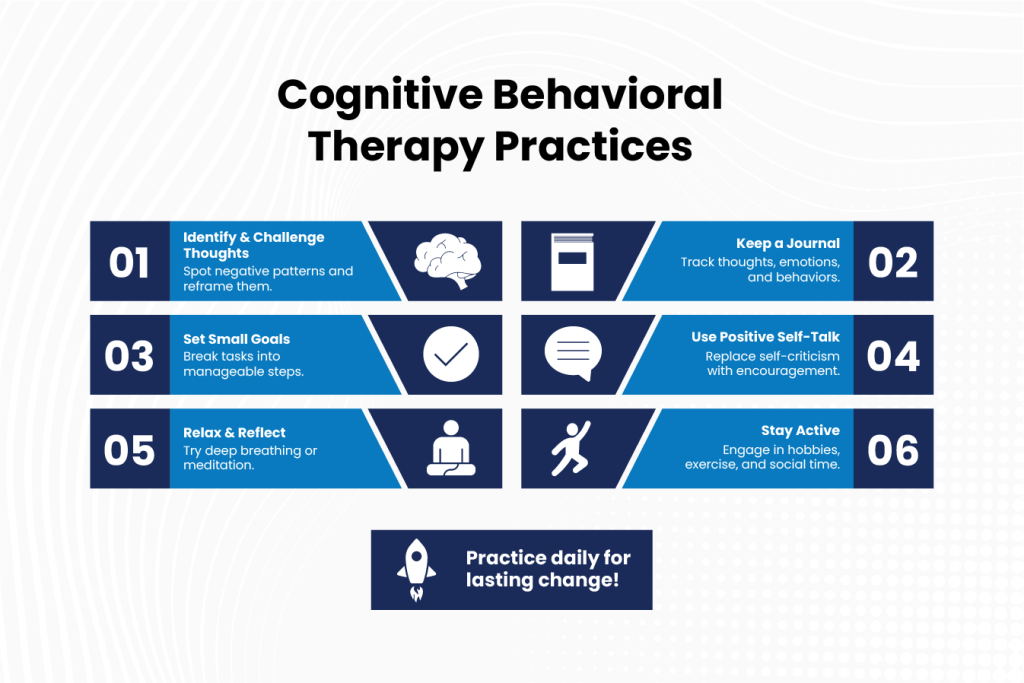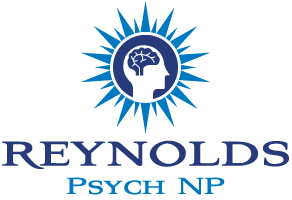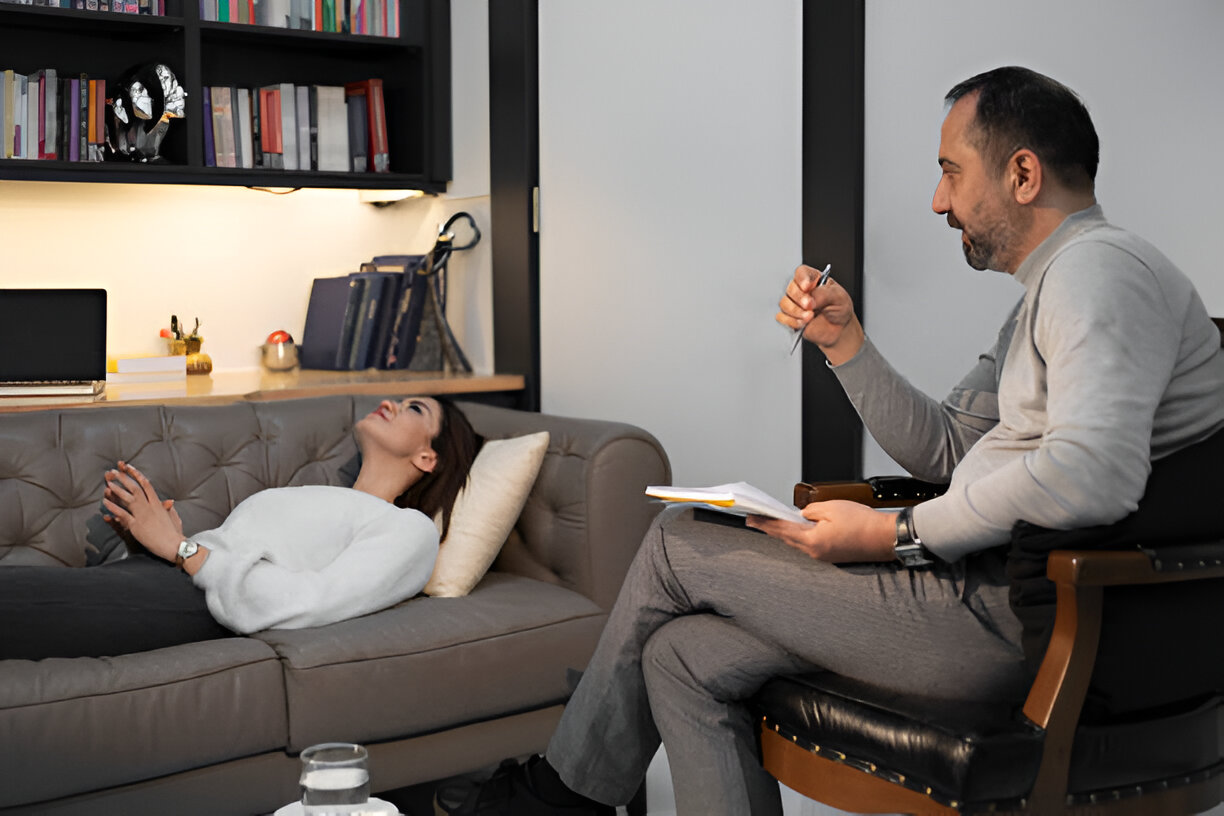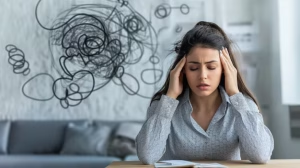How can I practice cognitive behavioral therapy at home? Let’s access the resources to change your way of thinking. People frequently ask about home-based practices for cognitive behavioral therapy. The right approach results in improved thought regulation and emotional health. The application of home-based CBT methods depends on both patience and consistency together with sound self-awareness. The usage of appropriate CBT tricks enables you to build resilience while achieving permanent beneficial outcomes.
10 Effective Ways to Practice Cognitive Behavioral Therapy at Home

1. Identify Negative Thought Patterns
The key to learning cognitive behavioral therapy at home is grasping thought distortions. Anxiety and self-doubt develop because people encounter automatic negative thoughts. What are some ways I can apply cognitive behavioral therapy at home? Begin by questioning: are these beliefs genuinely true?
The ability to detect typical behavioral patterns can help stop destructive mental regression patterns. Journaling, together with self-reflection, allows people to gain better insight into themselves. By undergoing such mental challenges, people develop a more objective view of situations.
2. Practice Mindfulness and Relaxation Techniques
Through mindfulness training, a person can develop better emotional stability and improved mental focus. A combination of deep breathing and guided meditation aids people in managing their stress. How can I go to practice cognitive behavioral therapy at home? Just by inhaling!
Speaking to one of the CBT methods, known as progressive muscle relaxation, leads to both anxiety reduction and tension relief. Daily mindfulness practice creates stronger emotional stability, together with enhanced focus abilities. Preserving the present state helps stop negative thinking patterns.
3. Keep a Thought Journal
A therapeutic home-based approach to Cognitive Behavioral Therapy (CBT) depends on writing down your thoughts.
- Track Negative Thoughts: Make a note of the negative thoughts that appear along with their effects on emotional responses.
- Identify Cognitive Distortions: The identification of patterns in catastrophizing, overgeneralization, and self-criticism should be acknowledged.
- Challenge Irrational Beliefs: We must transform pessimistic thinking through substitutions of accurate, rational perceptions.
- Observe Emotional Reactions: Determine through assessment which alterations in thought mechanics lead to changes in both psychological state and conduct.
- Monitor Progress: You should inspect past journal entries consistently for progress assessment.
4. Use Cognitive Restructuring Techniques
A person needs to challenge their unreasonable beliefs to achieve genuine transformation. Test any negative assumptions that naturally pop into your mind by using positive perspectives instead. Review your mental state to determine whether what you think represents reality or merely represents fears.
Through logical thinking practice, people develop capabilities to make rational decisions. Cognitive restructuring develops emotional strength as a person continues its practice. How to adopt cognitive behavioral therapy at home? To change your life, confront those thoughts and rewrite your story.
5. Engage in Behavioral Activation
CBT practices at home demand immediate implementation. Participation in constructive engagements helps to discourage emotional negativity. People who plan enjoyable activities improve both their motivation levels and their mental health condition.
Addressing behaviors that avoid the issue or problem will build self-confidence. Repeated minor steps lead both people and mental states toward better feelings and work efficiency. Take action instead of avoiding: embrace a more joyful version of yourself.
6. Set Realistic and Achievable Goals
The effective goal-setting technique explains how to perform cognitive behavioral therapy within your home environment.
- Define Clear Objectives: Create both short-term objectives and long-term objectives within mental health management.
- Break Goals into Steps: Purposeful goal setting starts by breaking objectives into smaller parts that can be handled step by step.
- Track Daily Progress: The use of checklists or journals functions as motivation maintainers.
- Adjust Goals When Needed: Plan adjustments remain necessary because circumstances may transform.
- Celebrate Small Wins: Positive behaviors should be acknowledged to gain reinforcement.
7. Challenge Avoidance Behavior
Running away from problems leads to the strengthening of negative emotions as well as fear levels. The process of confronting minor fears helps decrease stress levels while it develops self-assurance. People who practice exposure therapy can defeat difficult situations in life.
How to start cognitive behavioral therapy at home? Begin by facing those minor fears in your current situation. Building up tolerance to uncomfortable situations enhances emotional strength in people. The process of facing fears gradually through stages results in permanent positive results.
8. Develop Problem-Solving Skills
The application of practical problem-solving helps manage stressful situations so they do not control everyday activities. The process of dividing issues into smaller parts helps to lower anxiety levels. Going through multiple solutions for evaluation helps people think logically.
The process of developing actionable plans helps people build better confidence when facing possible challenges. Problem-solving ability development leads to stable emotional states. Analyze it, construct it: navigate your path to tranquility.
9. Create a Positive Self-Talk Routine
A person can learn home-based cognitive behavioral therapy by selecting positive language to answer this question.
- Replace Self-Criticism: You need to combat your negative thoughts by rewriting them with confident verbal statements.
- Use Evidence-Based Thinking: People should create their self-perceptions from real evidence instead of their doubts and fears.
- Speak to Yourself Kindly: Treating yourself kindly should match the same level of gentleness that you provide to your friends.
- Reinforce Strengths: Prioritize reaching your objectives along with your advancement while you ignore your inadequacies.
- Practice Daily Affirmations: Regular positive declaration helps people build confidence as well as their mental wellness.
10. Use CBT Tips to Maintain Long-Term Progress
The regular application of CBT techniques results in transformed behavioral patterns that persist. Repeated daily practice produces enduring mental practices. Self-reflection helps refine coping strategies over time. The process of requesting help results in personal development.
Devoted dedication to CBT leads to better mental stability over time. Consistency is your strength: minor daily actions lead to lasting transformation. What are some ways to apply cognitive behavioral therapy at home? Transforming it into a daily routine will help you create a stronger version of yourself.
Related Articles:
- Challenges in Medication Management
- Medication Management in Mental Health
- Right Psychiatric for Individual Counseling
Wrapping Up
Which techniques from cognitive behavioral therapy practice should I learn? It requires dedication and consistency. The implementation of home-based CBT practices builds a person’s ability to manage emotions while solving problems more effectively.
Reynolds Psych NP specializes in providing professional guidance for learning cognitive behavioral therapy applications in home environments. The team uses individual circumstances to deliver implementation strategies that result in practical outcomes.
Using CBT techniques enables patients to develop self-awareness and establish long-term beneficial changes in their behavior. Individual psychotherapy stands as an extra guided support with additional structure to help clients address their needs.
The practitioners at this center furnish their patients with structured methods from CBT that deal with personal issues. The professional team provides essential support which enables clients to keep making ongoing mental health development. For more details, email [email protected] OR contact: (262) 999-7350.
FAQs
What steps should I follow to practice cognitive behavioral therapy inside my residence?
The practice includes three steps: thought monitoring, writing in a journal, and using CBT therapeutic methods.
What does an effective home practice of CBT consist of?
The home treatment approach includes four components: mindfulness, cognitive restructuring, goal setting, and thought journaling.
What actions does the use of CBT techniques perform to enhance mental health?
These strategies help patients modify their negative thoughts while developing personal awareness, which leads to stronger emotional strength.
Can I overcome my anxiety and stress through CBT tips?
Yes! It serves as an effective approach for dealing with stress and anxiety. The structure exercises function as stress reducers while simultaneously improving rational decision-making.
Does individual psychotherapy form a requirement for practicing CBT?
Self-guided practice alone remains helpful although working with experts in therapy helps outcomes become more comprehensive and achieved at greater depths.
How does Reynolds Psych NP support mental health?
The organization delivers CBT techniques through experts who provide adapted wellness strategies for achieving long-term health goals.







